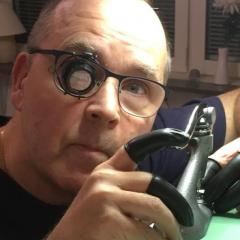Safety Cap Jewel Cleaning Tool created from peg wood
-
Recently Browsing
- No registered users viewing this page.
-
Topics
-
Posts
-
By DouglasSkinner · Posted
Thanks! I saw it. In fact, it's what reminded me that I had the tool. Mine is more complete and, at his request, I have sent the photo in this post to J. D. Richard. My main question is whether I have the complete tool, or is it missing any parts. My tool is more complete than J. D.s. I talked with my former watch instrutor, who also has one, and he says mine is complete. Still, I'd be interested in a demo of its use. -
By ManSkirtBrew · Posted
Recently picked this guy up, and took it apart for cleaning tonight. Looks super clean inside as far as wear and tear goes, but there are puddles of oil everywhere! Hopefully a good cleaning will bring the amplitude back up. I did learn that the automatic bridge is spring loaded, which you can see below in the yard sale of wheels and gears all over the place. Sorry in advance for all the pictures and if some aren't in perfect focus. I take a lot of progress pictures through my microscope, and I figure if someone is here looking for help, they might be useful to them. And this is where I stopped, since I got into the wine. -
By ManSkirtBrew · Posted
I EXTREMELY carefully pressed the seconds hand firmly back on, so fingers crossed. While I had it apart, I took the opportunity to press the Spaceview crystal back in, and I have a vintage Caravelle rally strap on its way to me. I do not get tired of how beautiful this watch is. -
Quartz watches like mechanical watches need to be serviced from time to time. If they been exposed to foreign substances like leaking batteries getting into their gear train then they definitely have to be serviced. But servicing a cheap quartz watch does not make economical sense it's cheaper just to replace the entire movement.
-
By watchweasol · Posted
Hi. When pulling the stem out to setting position look in the hole/s for a small tab moving into view this will br the release tab. Push gently. Attached is the user manual . You will need to skip through the Japanese version. Seiko 8B53 usermanual.pdf
-







Recommended Posts